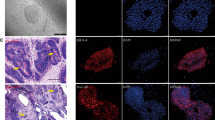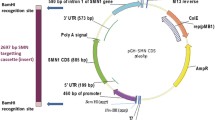Abstract
Objective
Charcot-Marie-Tooth disease (CMT) severely affects patient activity, and may cause disability. However, no clinical treatment is available to reverse the disease course. The combination of CRISPR/Cas9 and iPSCs may have therapeutic potential against nervous diseases, such as CMT.
Methods
In the present study, the skin fibroblasts of CMT type 2D (CMT2D) patients with the c.880G>A heterozygous nucleotide mutation in the GARS gene were reprogrammed into iPSCs using three plasmids (pCXLE-hSK, pCXLE-hUL and pCXLE-hOCT3/4-shp5-F). Then, CRISPR/Cas9 technology was used to repair the mutated gene sites at the iPSC level.
Results
An iPSC line derived from the GARS (G294R) family with fibular atrophy was successfully induced, and the mutated gene loci were repaired at the iPSC level using CRISPR/Cas9 technology. These findings lay the foundation for future research on drug screening and cell therapy.
Conclusion
iPSCs can differentiate into different cell types, and originate from autologous cells. Therefore, they are promising for the development of autologous cell therapies for degenerative diseases. The combination of CRISPR/Cas9 and iPSCs may open a new avenue for the treatment of nervous diseases, such as CMT.
Similar content being viewed by others
References
Rossor AM, Polke JM, Houlden H, et al. Clinical implications of genetic advances in Charcot-Marie-Tooth disease. Nat Rev Neurol, 2013,9(10):562–571
Peretti A, Perie M, Vincent D, et al. LRSAM1 variants and founder effect in French families with ataxic form of Charcot-Marie-Tooth type 2. Eur J Hum Genet, 2019,27(9):1406–1418
Sleigh JN, Dawes JM, West SJ, et al. Trk receptor signaling and sensory neuron fate are perturbed in human neuropathy caused by Gars mutations. Proc Natl Acad Sci USA, 2017,114(16):E3324–E3333
Mo Z, Zhao X, Liu H, et al. Aberrant GlyRS-HDAC6 interaction linked to axonal transport deficits in Charcot-Marie-Tooth neuropathy. Nat Commun, 2018,9(1):1007
Yoshida Y, Yamanaka S. Induced Pluripotent Stem Cells 10 Years Later: For Cardiac Applications. Circ Res, 2017,120(12):1958–1968
Firth AL, Menon T, Parker GS, et al. Functional Gene Correction for Cystic Fibrosis in Lung Epithelial Cells Generated from Patient iPSCs. Cell Rep, 2015,12(9):1385–1390
Grice SJ, Sleigh JN, Zameel Cader M. Plexin-Semaphorin Signaling Modifies Neuromuscular Defects in a Drosophila Model of Peripheral Neuropathy. Front Mol Neurosci, 2018,11:55
He W, Bai G, Zhou H, et al. CMT2D neuropathy is linked to the neomorphic binding activity of glycyl-tRNA synthetase. Nature, 2015,526(7575):710–714
Niehues S, Bussmann J, Steffes G, et al. Impaired protein translation in Drosophila models for Charcot-Marie-Tooth neuropathy caused by mutant tRNA synthetases. Nat Commun, 2015,6:7520
Ravi B, Antonellis A, Sumner CJ, et al. Genetic approaches to the treatment of inherited neuromuscular diseases. Hum Mol Genet, 2019,28(R1):R55–R64
Ortiz-Virumbrales M, Moreno CL, Kruglikov I, et al. CRISPR/Cas9-Correctable mutation-related molecular and physiological phenotypes in iPSC-derived Alzheimer’s PSEN2 (N141I) neurons. Acta Neuropathol Commun, 2017,5(1):77–96
Ou Z, Niu X, He W, et al. The Combination of CRISPR/Cas9 and iPSC Technologies in the Gene Therapy of Human beta-thalassemia in Mice. Sci Rep, 2016,6:32463
Hu X. CRISPR/Cas9 system and its applications in human hematopoietic cells. Blood Cells Mol Dis, 2016,62(2016):6–12
Sweeney CL, Merling RK, De Ravin SS, et al. Gene Editing in Chronic Granulomatous Disease. Methods Mol Biol, 2019,1982:623–665
Garcia-Leon JA, Vitorica J, Gutierrez A. Use of human pluripotent stem cell-derived cells for neurodegenerative disease modeling and drug screening platform. Future Med Chem, 2019,11(11):1305–1322
Kumar D, Anand T, Kues WA. Clinical potential of human-induced pluripotent stem cells: Perspectives of induced pluripotent stem cells. Cell Biol Toxicol, 2017,33(2):99–112
Chang CW, Lai YS, Westin E, et al. Modeling Human Severe Combined Immunodeficiency and Correction by CRISPR/Cas9- Enhanced Gene Targeting. Cell Rep, 2015,12(10):1668–1677
Author information
Authors and Affiliations
Corresponding authors
Additional information
Conflict of Interest Statement
The authors declare that they have no conflicts of interest.
This work was supported by grants from the National Major Scientific and Technological Special Project for “Significant New Drugs Development” (No. 2019ZX09301159), the “Thousand Talent Program” for Science and Technology Innovation Leader in Henan (No. 194200510002), the Bingtuan Science and Technology Project (No. 2019AB034), and the Natural Science Foundation of Henan Province of China (No. 202300410381).
Rights and permissions
About this article
Cite this article
Lu, Pj., Zhang, P., Liu, Yc. et al. Gene Repair of iPSC Line with GARS (G294R) Mutation of CMT2D Disease by CRISPR/Cas9. CURR MED SCI 43, 261–267 (2023). https://doi.org/10.1007/s11596-023-2707-8
Received:
Accepted:
Published:
Issue Date:
DOI: https://doi.org/10.1007/s11596-023-2707-8




